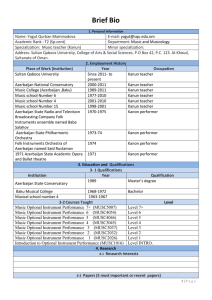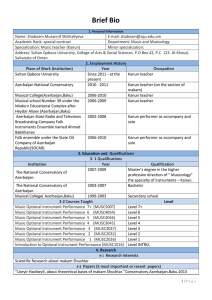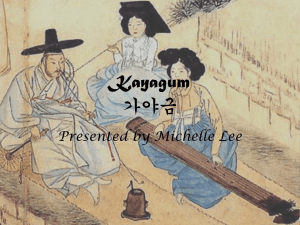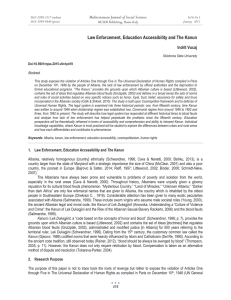Kanun - Healthy Boys, LLC
advertisement
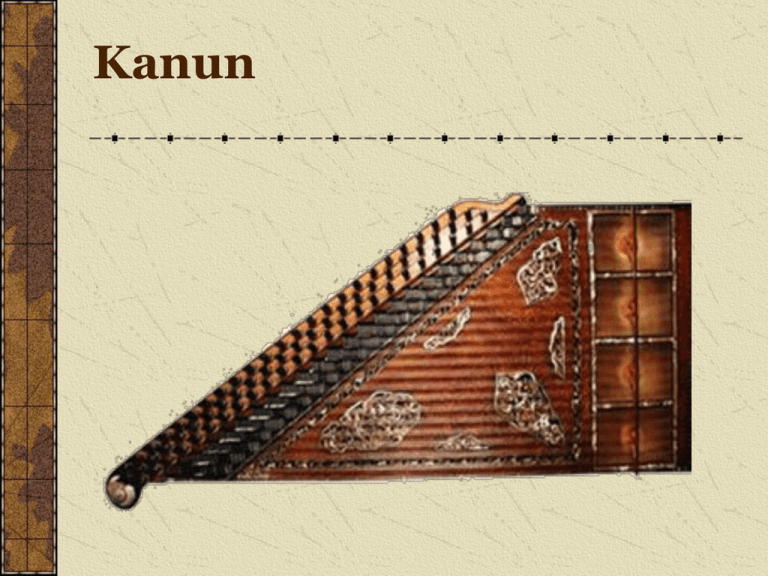
Kanun About the Kanun قانونqānūn κανων • • • • • • • • Turkish stringed instrument – core of Turkish music Also used throughout the Middle East, Armenia & Greece Trapazoid shape; approx. 37-39 in. x 14-16 in. Zither-like, played horizontally on the lap Kithara family of instruments 26 courses of strings, 3 strings per course Strings plucked with plectrums, one on each hand o mitzrab/p attached to thimbles that are worn on forefingers, made of ivory, tortoise-shell, or plastic o can also be played with fingernails, all fingers Can be accompanying instrument or solo instrument Construction • • • Made by hand from up to 7 kinds of wood Top: sycamore; back: pine; bridge: maple Designs cut out separately from rosewood or white pine • Strings originally made of catgut, now nylon or PVC • 200 tuning pegs, metal (brass, silver alpaca) or hardwood (ebony) • Sound board: fish skin or calf leather (where bridge rests upon) Approx. 10,000+ lbs. of string tension on the bridge • • Small tuning levers/keys, mandels, made of a metal alloy, cut into shape and highly polished; 4-12 per course Tuning A Mathematical Relationship Approximately 3.5 octave range (average) • 26 courses x 3 strings each course = 78 strings total • Each course = 1 full 100 cent tone in equal temperament • Mandals used to divide each course/tone into 4 or 6 units (octaves divided from semitones to quarter and sixth tones) • 72-tone tuning (related to “12 tone” of Western 20th century composition, which is a subset of 72-tone equal temperament) • 12 (tones) x 6 (possible subdivisions) = 72 tones • Number of mandels on kanuns are customized by performers • 79-tone tuning (new evolutionary tuning theory)† o recently proposed and applied by Ozan Yarman o acclaimed by Turkish kanun masters o Music Notation History & Origins • • • • • Related to ancient Egyptian harps; also related to psaltery, dulcimer, and zither (originating from between 2800-606 B.C.) Pythagoras kanon: one string experimental instrument with a moveable bridge (mathematical; Greek origin) Turkish kanun said to be invented by Islamic scholar Farabi, living in Turkistan in the 10th century (870-950 C.E.) Many believe it was developed much earlier by the Turks of Central Asia, traveling West to Anatolia and Arabia via Iran Albert Lavignac’s “Music and Musicians” (French, 1905) cited the Arabs as inventing the kanun (however, the French first had exposure to it during Napoleon’s 1792 Egyptian campaign) Tracing Kanun’s Development 14th century Persian treatise Kenzü't-Tuhaf: o diagram with written descriptions, measurements, shape o cites 64 strings tuned in sets of three Abdülkadir Meragî (d. 1435) o great composer, virtuoso, and theoretician o writes about kanun in treatises 15th century: used in Ottoman music; made structural changes 16th century: identical kanun used in Istanbul, Iran, Mesopotamia o made entirely of wood with metal strings o similar to the kalun used by the Uygurs today 18th century: began to resemble today’s kanun; found in Turkey and the Middle East (Egypt, Syria) Hizir Aga's Tefhîmü'l Makamât (1765~1770); modern kanun “Traditional” Links Solo: http://www.youtube.com/watch?v=Nw8gRNBpR1M http://www.youtube.com/watch?v=WDZEkv7sd30&NR=1 http://www.youtube.com/watch?v=6vKFrQvJmZM&feature=related With other instruments and singing: http://www.youtube.com/watch?v=idPPeO869BE&feature=related Modern & Hybrid Uses Kayazim 789: http://www.youtube.com/watch?v=eFwg6SF-T-U&NR=1 Western Orchestra “Concerto for Kanun and Strings”: http://www.youtube.com/watch?v=7ylI8Cmtx2M&NR=1 Hotel California: http://www.youtube.com/watch?v=H6z_MbPLvB4&feature=related
